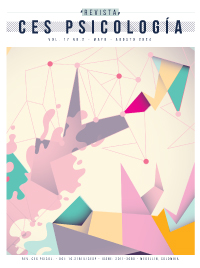Processing load does not facilitate access to quantity in coding tasks
DOI:
https://doi.org/10.21615/cesp.6609Keywords:
numerical cognition, numerical processing, visual recognition, perception, semantics, encoding processesAbstract
The present study examines the extent to which quantity representations associated with Arabic numerals (e.g., 7) influence how these numbers are recognised. The existence of faster responses in perceptual tasks (e.g., are 5 and 9 the same? is the following stimuli the number 5?) when the numerical distance between digit pairs is greater has thus far been the main evidence in favour of the automaticity of access to quantity representations and, therefore, of the influence of top-down processes on digit recognition. However, recent studies have shown that when perceptual similarity between digits is included as a predictor, the distance effect ceases to be a valid predictor in tasks that analyse early visual processes such as encoding and identification, with distance being relevant only when the task is later and requires quantitative knowledge (e.g., which number is larger/smaller between 5 and 9?). By adding a new variable to the question, that of processing load, it has been found that quantity representations intervene in the identification stage but only when multiple stimuli appear. The present study asks whether increasing the processing load at the earliest stage of the perceptual process, encoding, also grants a role to numerical distance. Twenty participants were asked to decide whether two simultaneously presented digits were the same or different, this under two conditions: in the load condition digits were flanked by symbols, in the no-load condition only the two single-digits were presented. Results were similar in both load conditions: perceptual similarity was the only valid predictor. Although perceptual load caused an increase in overall response times, it did not modify the predictive value of similarity and numerical distance.
Downloads
References
Blanc-Goldhammer, D., & Cohen, D. J. (2014). Unlimited capacity parallel quantity comparisons of multiple integers. Journal of Experimental Psychology: Learning, Memory, and Cognition, 40, 1389–1403. https://doi.org/10.1037/a0036843
Cohen, D. J. (2009). Integers do not automatically activate their quantity representation. Psychonomic Bulletin & Review, 16, 332–336. https://doi.org/10.3758/PBR.16.2.332
Cohen, D. J., & Quinlan, P. T. (2016). How numbers mean: Comparing random walk models of numerical cognition varying both encoding processes and underlying quantity representations. Cognitive Psychology, 91, 63–81. https://doi.org/10.1016/j.cogpsych.2016.10.002
Cohen, D. J., & Quinlan, P. T. (2019). Limited-capacity identity processing of multiple integers. Attention, Perception, & Psychophysics, 81(6), 1789–1804. https://doi.org/10.3758/s13414-019-01745-0
Dehaene, S., & Akhavein, R. (1995). Attention, automaticity, and levels of representation in number processing. Journal of Experimental Psychology: Learning, Memory, and Cognition, 21, 314–326. https://doi.org/10.1037/0278-7393.21.2.314
Dienes Z. (2014). Using Bayes to get the most out of non-significant results. Frontiers in Psychology, 5, 781. https://doi.org/10.3389/fpsyg.2014.00781
Ganor-Stern, D., & Tzelgov, J. (2008). Across-notation automatic numerical processing. Journal of Experimental Psychology: Learning, Memory, and Cognition, 34, 430–437. https://doi.org/10.1037/0278-7393.34.2.430
García-Orza, J., Comesaña, M., Piñeiro, A., Soares, A. P., & Perea, M. (2016). Is VIRTU4L larger than VIR7UAL? Automatic processing of number quantity and lexical representations in leet words. Journal of Experimental Psychology: Learning, Memory, and Cognition, 42(6), 855–865. https://doi.org/10.1037/xlm0000211
García-Orza, J., & Perea, M. (2011). Position Coding in Two-Digit Arabic Numbers. Experimental Psychology, 58, 85-91. https://doi.org/10.1027/1618-3169/a000071
García-Orza, J., Perea, M., Mallouh, R. A., & Carreiras, M. (2012). Physical similarity (and not quantity representation) drives perceptual comparison of numbers: Evidence from two Indian notations. Psychonomic Bulletin & Review, 19, 294–300. https://doi.org/10.3758/s13423-011-0212-8
García-Orza, J., Perea, M., & Muñoz, S. (2010). Are transposition effects specific to letters? The Quarterly Journal of Experimental Psychology, 63(8), 1603–1618. https://doi.org/10.1080/17470210903474278
Grainger, J., & Hannagan, T. (2014). What is special about orthographic processing? Written Language and Literacy, 17(2), 225–252. https://doi.org/10.1075/wll.17.2.03gra
Henik, A., & Tzelgov, J. (1982). Is three greater than five: The relation between physical and semantic size in comparison tasks. Memory & Cognition, 10, 389–395. https://doi.org/10.3758/BF03202431
Kinoshita, S., & Lagoutaris, S. (2010). Priming by numb3r5 does not involve top-down feedback. Journal of Experimental Psychology: Learning, Memory, and Cognition, 36(6), 1422–1440. https://doi.org/10.1037/a0020609
Lavie, N. (2010). Attention, distraction, and cognitive control under load. Psychological Science 19(3), 143–148.
Lorch, R. F., Jr., & Myers, J. L. (1990). Regression analyses of repeated measures data in cognitive research. Journal of Experimental Psychology: Learning, Memory, and Cognition, 16, 149– 157. https://doi.org/10.1037/0278-7393.16.1.149
McCloskey, M. (1992). Cognitive mechanisms in numerical processing: Evidence from acquired dyscalculia. Cognition, 44, 107–157. https://doi.org/10.1016/0010-0277(92)90052-j
McCloskey, M., & Schubert, T. (2014). Shared versus separate processes for letter and digit identification. Cognitive Neuropsychology, 31(5-6), 437-460.
Pavese, A., & Umiltà, C. (1998). Symbolic distance between numerosity and identity modulates Stroop interference. Journal of Experimental Psychology: Human Perception and Performance, 24(5), 1535–1545. https://doi.org/10.1037/0096-1523.24.5.1535
Schneider, W., Eschman, A., & Zuccolotto, A. (2012). E-Prime User's Guide. Pittsburgh: Psychology Software Tools, Inc.
Shiffrin, R. M., & Gardner, G. T. (1972). Visual processing capacity and attentional control. Journal of Experimental Psychology, 93, 72–82. https://doi.org/10.1037/h0032453
The JASP Team. (2020). JASP (Version 0.14.1) [Computer software]. https://jasp-stats.org/.
Van Doorn, J., van den Bergh, D., Böhm, U., Dablander, F., Derks, K., Draws, T., Etz, A., Evans, N.J., Gronau, Q.F., Haaf, J.M., Hinne, M., Kucharský, S., Ly, A., Marsman, M., Matzke, D., Gupta, A.R.K.N., Sarafoglou, A., Stefan, A., Voelkel, J.G., & Wagenmakers, E.J. 2021). The JASP guidelines for conducting and reporting a Bayesian analysis. Psychonomic Bulletin & Review, 28, 813–826. https://doi.org/10.3758/s13423-020-01798-5
Van Opstal, F., de Lange, F. P., & Dehaene, S. (2011). Rapid parallel semantic processing of numbers without awareness. Cognition, 120(1), 136–147. https://doi.org/10.1016/j.cognition.2011.03.005
Welford, A. T. (1960). The measurement of sensory–motor performance: Survey and reappraisal of twelve years’ progress. Ergonomics, 3, 189–230.
Wong, B., & Szücs, D. (2013). Single-digit Arabic numbers do not automatically activate magnitude representations in adults or in children: Evidence from the symbolic same–different task. Acta Psychologica, 144, 488–498. https://doi.org/10.1016/j.actpsy.2013.08.006
Zhang, L., Xin, Z., Feng, T., Chen, Y., & Szücs, D. (2018). Physical similarity or numerical representation counts in same–different numerical comparison, physical comparison and priming tasks? Quarterly Journal of Experimental Psychology, 71, 670–687. https://doi.org/10.1080/17470218.2016.1276944
Downloads
Published
How to Cite
Issue
Section
License
Copyright (c) 2024 Javier García-Orza, Ana Calviño, Patricia Carratalá Cepedal

This work is licensed under a Creative Commons Attribution-NonCommercial-ShareAlike 4.0 International License.
Each manuscript is accompanied by a statement specifyingThat the materials are unpublished, that have not been previously published in printed formatElectronic and that they will not be presented to any other means before knowing the decision of the magazine. ThroughoutIn case, any previous publication, sea in printed or electronic form, must be made known to the editorial staffWriting The authors attach a signed statement stating that, and the manuscript is acceptedFor publication, the rights of reproduction are the exclusive property of the Journal CES Psychology.| Article metrics | |
|---|---|
| Abstract views | |
| Galley vies | |
| PDF Views | |
| HTML views | |
| Other views | |




